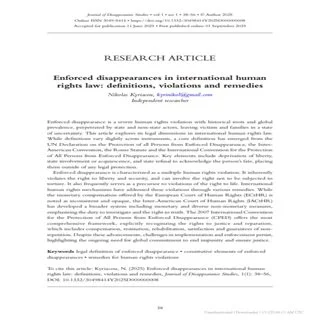Enforced Disappearances in International Human Rights Law: Definitions, Violations and Remedies
By Nikolas Kyriacou
Enforced disappearance is a severe human rights violation with historical roots and global prevalence, perpetrated by state and non-state actors, leaving victims and families in a state of uncertainty. This article explores its legal dimensions in international human rights law. While definitions vary slightly across instruments, a core definition has emerged from the UN Declaration on the Protection of all Persons from Enforced Disappearance, the Inter-American Convention, the Rome Statute and the International Convention for the Protection of All Persons from Enforced Disappearance. Key elements include deprivation of liberty, state involvement or acquiescence, and state refusal to acknowledge the person’s fate, placing them outside of any legal protection.
Enforced disappearance is characterized as a multiple human rights violation. It inherently violates the right to liberty and security, and can involve the right not to be subjected to torture. It also frequently serves as a precursor to violations of the right to life. International human rights mechanisms have addressed these violations through various remedies. While the monetary compensation offered by the European Court of Human Rights (ECtHR) is noted as inconsistent and opaque, the Inter-American Court of Human Rights (IACtHR) has developed a broader system including monetary and diverse non-monetary measures, emphasizing the duty to investigate and the right to truth. The 2007 International Convention for the Protection of All Persons from Enforced Disappearance (CPED) offers the most comprehensive framework, explicitly recognizing the rights to justice and reparation, which includes compensation, restitution, rehabilitation, satisfaction and guarantees of non-repetition. Despite these advancements, challenges in implementation and enforcement persist, highlighting the ongoing need for global commitment to end impunity and ensure justice.
Journal of Disappearance Studies, v. 1, 2025.


